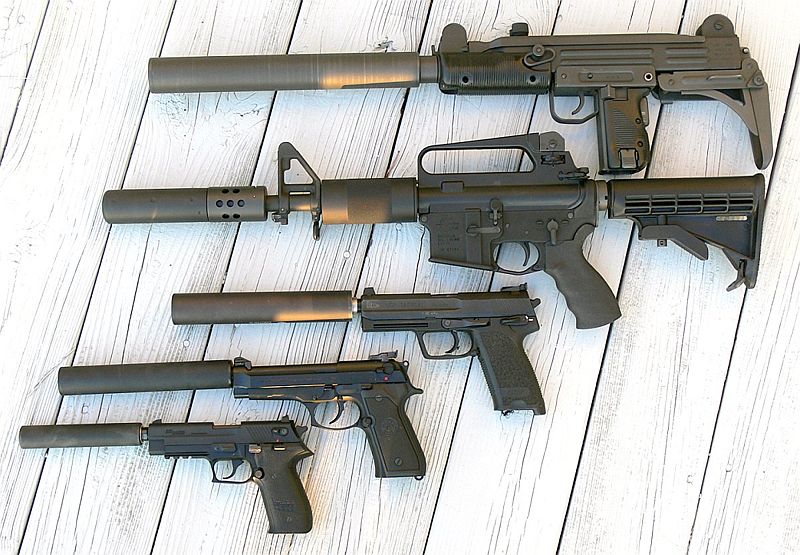
By Kyle Steenland, Staff Writer
One of the nation’s largest gun control acts, the National Firearms Act of 1968, is facing legislation that would remove one of its most regulated items: suppressors.
House Bill 367, named the Hearing Protection Act of 2017, was introduced in the House of Representatives, aiming to eliminate the excise tax placed on suppressors and remove them from being subjected to the purchasing process prescribed by the National Firearms Act.[1][2] The Bureau of Alcohol, Tobacco, Firearms, and Explosives (ATF) requires would-be purchasers of suppressors to obtain ATF approval; undergo a background check including identifying photographs and fingerprints; and pay a $200 tax.[3]
After the bill, would-be purchasers would be required to undergo a background check operated by the FBI’s Criminal Justice Information Services division known at the National Instant Criminal Background Check (NICS). Currently, NICS is the system utilized in the purchase of any firearm from a Federal Firearm Licensee (FFL). Since its inception in 1998, it has had over 230 million checks with more than 1.3 million denials.[4]
The National Firearms Act of 1968 (NFA) initially began in 1934 after the well-publicized gangster violence led by those such as Al Capone, John Dillinger, and Bonnie and Clyde. Specifically, after the St. Valentine’s Day Massacre, which killed seven men in a Prohibition-fueled gangland struggle,[5] Congress passed the National Firearms Act of 1934.[6] Congress promptly introduced the NFA, hoping the additional criminal sanctions for unregistered possession of such firearms — and $200 excise tax, then valued at over $3,000 — would curb gangland fueled shootings. This act specifically targeted firearms used in gangland style crimes, such as automatic firearms, and short-barreled firearms, such as shotguns and rifles. Further, a class described as “any other weapons,” including suppressors, also found itself subject to NFA regulations.
In 1968, the Supreme Court encountered an issue of first impression in Haynes v. United States,[7] holding that a felon in possession of NFA items was not required to register them, as it would constitute self-incrimination and thus violate Fifth Amendment protections. This forced Congress to update and revise the previous version of the bill.
Clearly Congress’ motivations then were to discourage mob-motivated criminal activity, but today, is that still the case? In an era where mob-motivated killings have shifted away from typical criminal enterprise and Godfather-esque occurrences and into poverty stricken gang shootings, is this legislation effective at curbing what it initially set out to do?
In evaluating the effectiveness of this bill, there are few insightful resources. The FBI publishes a yearly Uniform Crime Report. It fails, however, to report or make note of the use of an NFA item in its murder statistics.
It does report the usage of various firearms and weapons in murder in data as recently as 2015, however. Of the 13,445 individuals murdered in 2015, firearms were utilized in 9,616 of them. But of this striking statistic, 6,447 involved the use of handguns, and not the regulated short-barreled shotgun or rifle. Rifles and shotguns together constituted 521 murders, which is a fraction of those killed by knives and cutting instruments: 1,544. The two closest contenders to the combined rifles and shotgun statistic are blunt objects, constituting 437 murders, and personal weapons, such hands, feet, or fists, constituting 623.[8] Furthermore, the FBI reports that only 175 of these nearly 10,000 murders were classified as “gangland killings” and an additional 578 as “juvenile gang killings.”[9]
The FBI does not elaborate on the methods of killing within these specific statistics. But with over 1.4 million NFA firearm applications in 2015, if NFA items were still utilized in gangland-motivated criminal activity, one would presume this statistic would be higher.[10]
Although this new bill offers no specific wording regarding statutory intent, one can presume by the title “Hearing Protection Act” that the bill hopes to protect the hearing capabilities of firearms enthusiasts. This is certainly a deviation from its historical roots. Perhaps with the changing criminal landscape, the regulation pendulum is now swinging toward more effective means.
Sources
[1] https://www.congress.gov/115/bills/hr367/BILLS-115hr367ih.pdf
[2] https://www.atf.gov/rules-and-regulations/national-firearms-act
[3] https://www.atf.gov/file/100896/download
[4] https://www.fbi.gov/services/cjis/nics
[5] http://www.history.com/topics/saint-valentines-day-massacre
[6] https://www.atf.gov/rules-and-regulations/national-firearms-act
[7] 390 U.S. 85 (1968).
[8] https://ucr.fbi.gov/crime-in-the-u.s/2015/crime-in-the-u.s.-2015/tables/expanded_homicide_data_table_8_murder_victims_by_weapon_2011-2015.xls
[9] https://ucr.fbi.gov/crime-in-the-u.s/2015/crime-in-the-u.s.-2015/tables/expanded_homicide_data_table_11_murder_circumstances_by_weapon_2015.xls
[10] https://www.atf.gov/resource-center/data-statistics